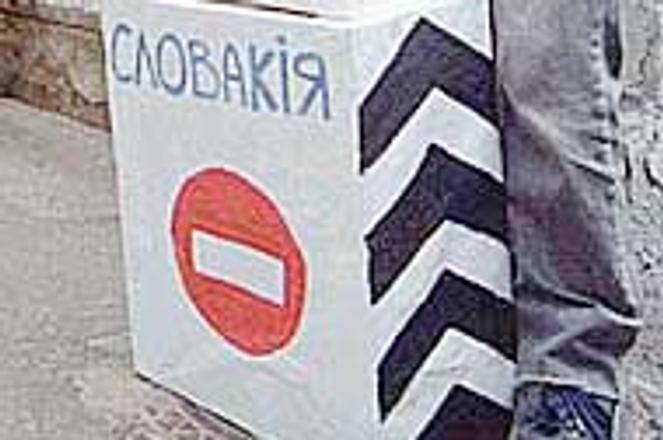A Ukraine activist groups called 'No Borders' protests in Kiev against Slovak visa regulations.photo: TASR
BORDER police intercepted another 60 illegal migrants from various countries on the Slovak-Ukraine border January 30. Despite calls this year from Interior Minister Ivan Šimko to tighten the country's eastern frontier, and pressure from the European Union to stem the tide of migrants coming to EU shores, the movement of people looking for better conditions shows no sign of abating.
Beyond border patrols and raids on people smuggling operations, the Interior Ministry has a relatively restrictive visa policy for foreign visitors. Slovakia now bars some 3.8 billion people - or 61% of the world population - from visiting Slovakia for tourist purposes on an individual basis.
Foreigners who wish to travel to Slovakia are divided into three groups. Citizens of most of the developed world, and those from EU candidate countries, can enter the country without a visa.
The second group, comprising most Latin American countries but also many ex-Soviet republics and a few Asian countries (including Japan) are subject to a regular visa regime.
Finally, the largest group in terms of population is subject to a so-called special visa regime (SVR). Potential individual tourist visitors may get a Slovak visa only after producing a letter of invitation from a close relative or from a business, a tour package operator or an organization in Slovakia.
The SVR group currently includes much of Africa, most of Asia (including China and India) and five European countries: Albania, Bosnia, Macedonia, Turkey and Yugoslavia.
"These countries are under the SVR regime in the interests of Slovakia's national security," explained Michal Borgula, deputy director of the Interior Ministry's Border and Foreigners' Control Office.
There are three basic criteria for putting a country on the SVR list, said Mirek Karas of the Consular Department at the Foreign Ministry. First, the more crimes committed by citizens of a given country in Slovakia, the more likely the country is to be under the SVR. The same goes for countries which are frequently the source of illegal migrants to Slovakia.
Similarly, the number of illegal attempts to leave Slovakia for the West will count against the country of the migrants' origin. "In principle, those countries are listed from which the migration of criminals to Slovakia is likely," added Karas.
Interior Ministry records show that in 2000 there were 6,016 illegal migrants detained in Slovakia, down from the high of over 8,200 people in 1998. Most of them came from Afghanistan, India, Romania, Sri Lanka and China.
From 1993 to 2000, about 35,000 people crossed the Slovak border (in or out of the country) illegally. Many illegals seek their way westwards, mostly through the Czech Republic or Austria. Last November, Austrian border guards stopped 149 migrants leaving Slovakia without travel documents, most of them Afghanis. Incidents like these put Slovakia under constant pressure to fight illegal migration.
However, countries far richer than Slovakia draw hundreds of thousands of illegal migrants annually, yet choose not to banish whole nations because of the crimes of their compatriots. Paul Oglesby, spokesman for the US embassy in Bratislava, said that "there is nothing barring citizens from certain countries from applying for a visa to the US."
He added: "Of course, a person's country of origin is one of many factors that are taken into consideration when considering whether to grant a visa."
Slovakia's neighbors share the developed countries' approach. Generally, countries are grouped into those with citizens free to visit, and those who need a visa. No special regime is implemented that would prevent individual tourist travel across the board. "It would be absurd to rule out a whole country rather than an individual", said an official with the Hungarian embassy in Bratislava.
The Czech Republic does not have an SVR either (it abolished the practice in the late 1990s), even though there were almost 33,000 illegal migrants registered in the Czech Republic last year, five and a half times more than in Slovakia.
Ivo Samson, an analyst at the Slovak Foreign Policy Association, said he thought the SVR was a legitimate tool, and that a regular visa regime would not work in Slovakia. "There's no way a visa official can figure out whether an applicant is a tourist or a refugee," said Samson. "With EU and Nato integration as the main foreign policy goals, such an approach from the Slovak government is understandable."
Nevertheless, the tension between national security and freedom of movement appears difficult even for Slovak government officials to reconcile.
During an exodus of Slovak Roma to EU countries in the past five years, Slovakia often urged the affected countries not to impose a visa regime on all Slovaks.
"If an iron curtain fell on Slovakia because of 90 Roma asylum applicants, we would consider it politically unfair," said Foreign Minister Eduard Kukan in late April 2001.
Author: Gabriel Sipos


